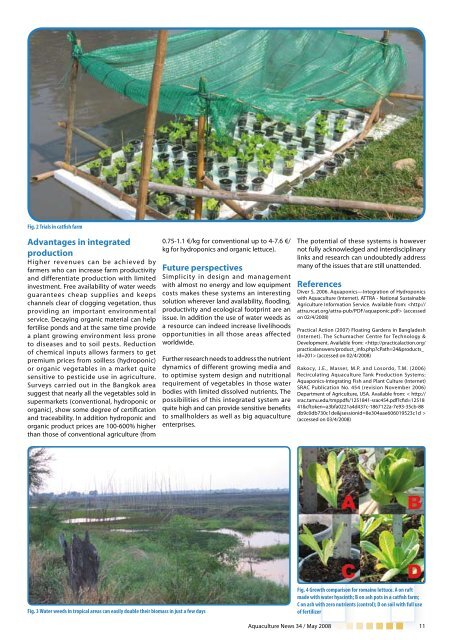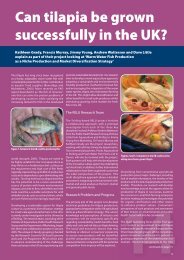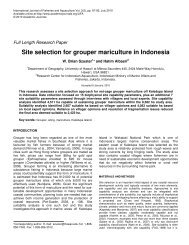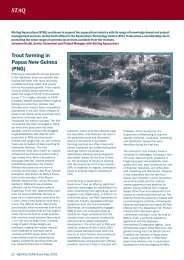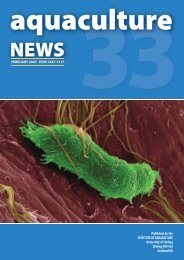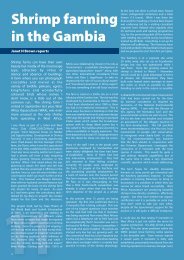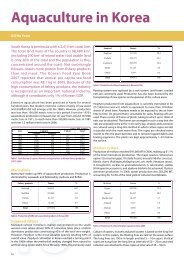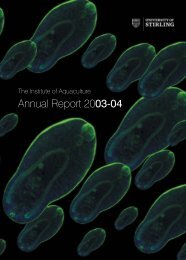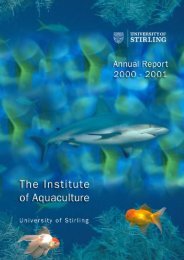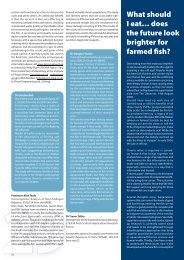Pond aquaponics: new pathways to sustainable integrated ...
Pond aquaponics: new pathways to sustainable integrated ...
Pond aquaponics: new pathways to sustainable integrated ...
Create successful ePaper yourself
Turn your PDF publications into a flip-book with our unique Google optimized e-Paper software.
Fig. 2 Trials in catfish farmAdvantages in <strong>integrated</strong>productionHigher revenues can be achieved byfarmers who can increase farm productivityand differentiate production with limitedinvestment. Free availability of water weedsguarantees cheap supplies and keepschannels clear of clogging vegetation, thusproviding an important environmentalservice. Decaying organic material can helpfertilise ponds and at the same time providea plant growing environment less prone<strong>to</strong> diseases and <strong>to</strong> soil pests. Reductionof chemical inputs allows farmers <strong>to</strong> getpremium prices from soilless (hydroponic)or organic vegetables in a market quitesensitive <strong>to</strong> pesticide use in agriculture.Surveys carried out in the Bangkok areasuggest that nearly all the vegetables sold insupermarkets (conventional, hydroponic ororganic), show some degree of certificationand traceability. In addition hydroponic andorganic product prices are 100-600% higherthan those of conventional agriculture (from0.75-1.1 €/kg for conventional up <strong>to</strong> 4-7.6 €/kg for hydroponics and organic lettuce).Future perspectivesSimplicity in design and managementwith almost no energy and low equipmentcosts makes these systems an interestingsolution wherever land availability, flooding,productivity and ecological footprint are anissue. In addition the use of water weeds asa resource can indeed increase livelihoodsopportunities in all those areas affectedworldwide.Further research needs <strong>to</strong> address the nutrientdynamics of different growing media and<strong>to</strong> optimise system design and nutritionalrequirement of vegetables in those waterbodies with limited dissolved nutrients. Thepossibilities of this <strong>integrated</strong> system arequite high and can provide sensitive benefits<strong>to</strong> smallholders as well as big aquacultureenterprises.The potential of these systems is howevernot fully acknowledged and interdisciplinarylinks and research can undoubtedly addressmany of the issues that are still unattended.ReferencesDiver S, 2006. Aquaponics—Integration of Hydroponicswith Aquaculture (Internet). ATTRA - National SustainableAgriculture Information Service. Available from: (accessedon 02/4/2008)Practical Action (2007) Floating Gardens in Bangladesh(Internet). The Schumacher Centre for Technology &Development. Available from: (accessed on 02/4/2008)Rakocy, J.E., Masser, M.P. and Losordo, T.M. (2006)Recirculating Aquaculture Tank Production Systems:Aquaponics-Integrating Fish and Plant Culture (Internet)SRAC Publication No. 454 (revision November 2006)Department of Agriculture, USA. Available from: < http://srac.tamu.edu/tmppdfs/1251841-srac454.pdf?cfid=1251841&cf<strong>to</strong>ken=a3bfa0221a4d437c-1867122a-7e93-35cb-88db9c0db730c1de&jsessionid=8e304aae606019523c1d >(accessed on 03/4/2008)Fig. 3 Water weeds in tropical areas can easily double their biomass in just a few days11Aquaculture News 34 / May 2008 11Fig. 4 Growth comparison for romaine lettuce. A on raftmade with water hyacinth; B on ash pots in a catfish farm;C on ash with zero nutrients (control); D on soil with full useof fertilizer


